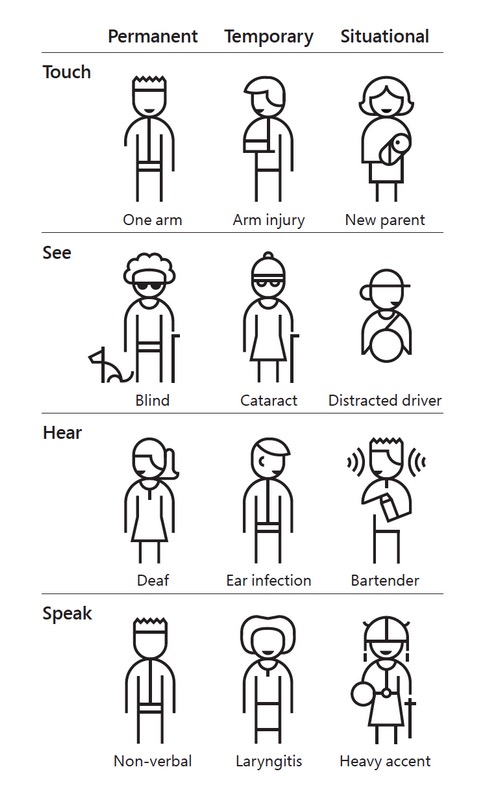Reading
The Microsoft Inclusive Design toolkit available as a resource on the Microsoft Design page.
Designing for inclusivity not only opens up our products and experiences to more people with a wider range of abilities. It also reflects how people really are. All humans are growing, changing, and adapting to the world around them every day. We want our designs to reflect that diversity. Every decision we make can raise or lower barriers to participation in society. It’s our collective responsibility to lower these barriers though inclusive products, services, environments, and experiences.
Lot of useful things in there, including a selection of examples of situational disability (i.e. how pretty much everyone is only 1 or 2 slight steps away from being disabled).

As always, suddenly realising things affect lots of people shouldn’t be the drive to make things better for what you previously thought was a small group of people, but if it’s things like this that prompt people to change their approach, I’m all for it. Curb cut effect is real.
5 most annoying website features I face as a blind person every single day by Holly Tuke.
On a related note, a reminder of some things that really shouldn’t be things these days. Nothing groundbreaking here, but the fact that these ‘simple’ things still need attention is pretty damning tbh. Plenty of web developers out there running before they can walk.
For blind and visually impaired people like me, accessibility is the difference between us being able to use a website and clicking off it.
Listening to
99% Invisible 407: The Dolphin that Roared.
A brief history of Anguilla via a memory of a flag with some dolphins on it. Tbh, 100% of the knowledge I currently have about Anguilla comes from this episode. Another sterling example of British fuckery.
Anguilla’s soil wasn’t fertile enough for large-scale agriculture, and according to Hodge, if the British couldn’t establish the same large slave plantations on Anguilla that were common in the rest of the Caribbean, then they didn’t have much use for it. So for decades, centuries even, the British basically ignored the island which meant Anguilla got very little funding for development.
It’s a tale of colonisation, revolution, graphic design, and has a somewhat happy ending. After listening to the episode, I did look up a little more about Anguilla and in a nutshell, it looks gorgeous. Well worth a trip; keeping all this complicated history in mind.
